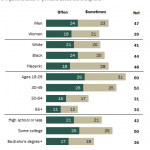Content Table:
- 1 Online Games – The Evolution
- 1.1 The Early Days: Single Player to Multi-Player
- 1.2 The 1970s: The Home Console Revolution
- 1.3 The 1980s: Video Game Boom, But No Online Yet
- 1.4 The 1990s: The Birth of Online Multiplayer
- 1.5 Online Flash Games and Web-Based Gaming
- 1.6 The 21st Century: The Era of Global Gaming
- 1.7 The Ever-Changing Landscape of Gaming Technology
Online Games – The Evolution
Online gaming has come a long way since its early beginnings, evolving alongside the technology that powers it. From the first attempts at creating interactive computer-based games to the massive multiplayer environments we enjoy today, the history of online gaming is a fascinating journey through technological innovation and social interaction. Let’s take a look at how online gaming has evolved over the decades.
The Early Days: Single Player to Multi-Player
In the early days of computer gaming, games were primarily single-player experiences. Early computer games involved basic objectives like solving puzzles or controlling characters in simple environments. One of the first significant developments in gaming history was the introduction of games that allowed players to compete with or against each other, bringing a new level of excitement and complexity to gaming.
A major step forward was the creation of DUNGEN, a multiplayer game where users competed to complete quests in a fantasy world. DUNGEN introduced new settings and challenges each time a player logged on, laying the groundwork for the development of future online multiplayer games.
The 1970s: The Home Console Revolution
By the late 1970s, video games were becoming increasingly popular as more households gained access to personal computers. As a result, many hobbyists started programming their own games, sharing or selling them in local markets. This was a time of experimentation and creativity in game development.
A significant shift occurred with the introduction of home gaming consoles that used game cartridges, allowing users to collect multiple games for a single console. This was a game-changer compared to the bulky game systems that had been previously required to play different games.
The 1980s: Video Game Boom, But No Online Yet
During the 1980s, video games exploded in popularity, but the concept of online gaming was still not fully realized. This decade saw the rise of iconic games such as Pole Position and Pac-Man, which captured the public’s imagination with their addictive gameplay and improved graphics. In 1985, Nintendo introduced the Nintendo Entertainment System (NES), which helped establish home console gaming as a staple in households worldwide.
The 1990s: The Birth of Online Multiplayer
The 1990s were a revolutionary period for gaming. With the advent of 3D graphics and multimedia capabilities, gaming became more immersive than ever before. One of the most significant developments was the introduction of the CD-ROM format, which allowed for much more complex and visually rich games like Myst. Games began to push the boundaries of what was possible with sound, graphics, and storytelling.
This was also the decade in which First-Person Shooter (FPS) games, like Quake, took off. The Internet was expanding rapidly, and MUDs (Multi-User Dungeons) opened the door to the first true online multiplayer experiences. By the late 1990s, players from around the world could battle it out in real-time strategy (RTS) games and action-packed FPS environments, or explore massive virtual worlds together.
Online Flash Games and Web-Based Gaming
As the Internet became more widely available, simple online games began to emerge. Websites started to offer free games like Tetris, Mario Bros, and Super Mario, which could be played right from a web browser. These online flash games were quick to load, easy to play, and accessible to anyone with an Internet connection, helping to bring online gaming into mainstream culture.
The 21st Century: The Era of Global Gaming
The early 2000s saw the gaming industry take full advantage of DVD and CD-ROM technology, with consoles like Sony’s PlayStation and Microsoft’s Xbox gaining popularity worldwide. These systems featured networking capabilities that allowed players to compete and collaborate in real-time with others from across the globe. Online gaming was no longer just a niche hobby’it became a massive, mainstream form of entertainment.
Broadband Internet services also contributed to this surge, providing the fast, reliable connections needed for seamless online play. Games like World of Warcraft and Halo 2 brought online gaming to a whole new level, with millions of players interacting in shared virtual worlds.
The Ever-Changing Landscape of Gaming Technology
One of the few drawbacks to the rapid evolution of online gaming technology is that new advancements can make hardware and games obsolete relatively quickly. For serious gamers, this means staying on top of the latest trends, but it also fuels a thriving resale market for older games and systems.
As online gaming continues to grow and evolve, we can only imagine what the future holds. One thing is for sure: the global gaming community has never been larger or more connected, and the possibilities for new, innovative gaming experiences are endless.
The evolution of online games is far from over, and as technology continues to improve, so too will the scope and complexity of the games we play. From humble beginnings in the 1970s to the global phenomenon it is today, online gaming has truly changed the way we play, interact, and experience virtual worlds.



